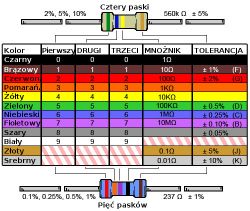Hello.
I read and ask questions.
I understand that it makes no difference which side the resistor is soldered in, e.g. https://www.google.com/search?q=rezystor&clie...CpwQ_AUIDigB&biw=1280&bih=888#imgrc=81klBoOys wDn7M:
There are four colors, I understand that it doesn`t matter which side I solder - brown or gold?
I understand that the colors mean the power of the resistor and nothing else?
Of course, I mean a resistor with two legs.
I read and ask questions.
I understand that it makes no difference which side the resistor is soldered in, e.g. https://www.google.com/search?q=rezystor&clie...CpwQ_AUIDigB&biw=1280&bih=888#imgrc=81klBoOys wDn7M:
There are four colors, I understand that it doesn`t matter which side I solder - brown or gold?
I understand that the colors mean the power of the resistor and nothing else?
Of course, I mean a resistor with two legs.



